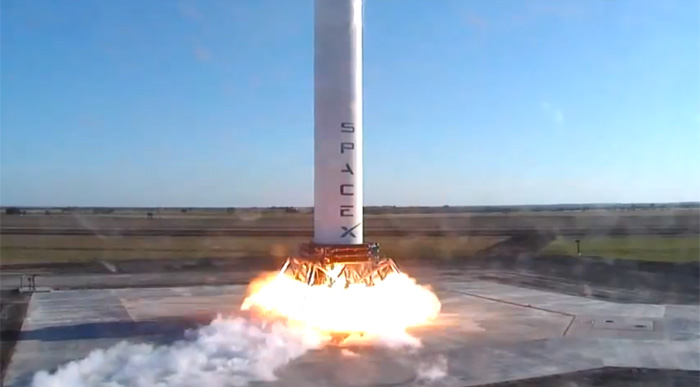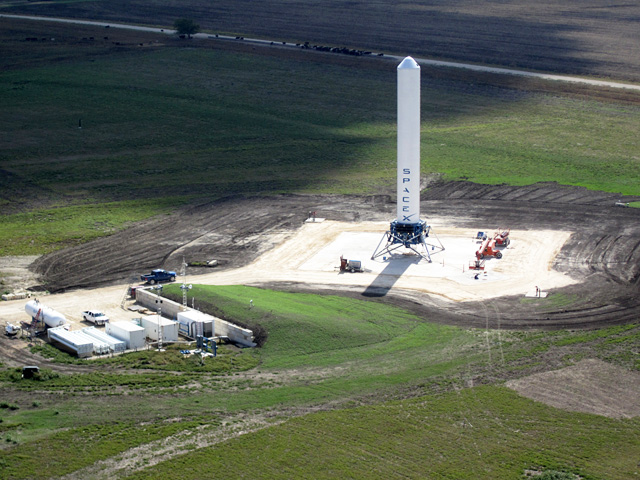Private Reusable Rocket Prototype Takes 2-Story Test Hop

A reusable rocket prototype built by the private spaceflight company SpaceX has made its highest flight yet, a two-story test hop, as part of an ambitious project to develop completely reusable rockets and spaceships.
SpaceX's Grasshopper reusable rocket is a 10-story-tall test vehicle for vertical launch and landing, meaning rockets could not only lift straight up into the sky, but return down to Earth the same way, gently touching down on land when the mission is completed.

For Grasshopper's second test flight, the vehicle hopped nearly two stories (17.7 feet, or 5.4 meters), and then touched down safely on its launch pad. The test, which lasted 8 seconds, took place at SpaceX's rocket testing facility in McGregor, Tex., on Nov. 1.
No complete rocket has ever landed intact after launching to space.While NASA's space shuttle orbiters were reusable — the winged space planes glided back to Earth and landed on runways — the solid rocket boosters and external tank that helped them reach orbit were not fully recyclable.
But Grasshopper is part of SpaceX's attempt to change this. [SpaceX Grasshopper Rocket Makes 2-Story Hop (Video)]
Grasshopper includes the first stage of SpaceX's Falcon 9 rocket, which launched the company's unmanned Dragon capsule to the International Space Station twice this year. That full rocket includes two stages and stands nearly 227 feet tall (70 meters). The Grasshopper test vehicle also carries a SpaceX Merlin-1D engine, four steel landing legs, and a steel support structure.
SpaceX's first Grasshopper test flight occurred Sept. 21, when the vehicle made a 6-foot hop before landing safely on the ground. Another test jump is planned soon, to take the vehicle up 100 feet (33 meters) and back down.
Get the Space.com Newsletter
Breaking space news, the latest updates on rocket launches, skywatching events and more!
The project is part of the commercial space firm's ultimate goal of making space launches cheaper by creating the first fully reusable spacecraft. SpaceX founder Elon Musk first announced the plan in September 2011.
"SpaceX believes that developing vehicles that are fully and rapidly reusable is a key element to radically reducing cost and increasing the efficiency of spaceflight," SpaceX spokeswoman Katherine Nelson told SPACE.com.
Ultimately, SpaceX envisions using three recyclable components to travel to space: a rocket first stage, a rocket second stage, and a cone-shaped space capsule. Each component would return separately to Earth and touch down safely on land to be refurbished for future missions. (Landing on land rather than at sea is preferable, because salt water makes it harder to reuse hardware).
SpaceX intends its capsule to use parachutes to cushion its landing, but the rocket stages will have engines to control their flights back down.
Follow SPACE.com on Twitter @Spacedotcom. We're also on Facebook & Google+.
Join our Space Forums to keep talking space on the latest missions, night sky and more! And if you have a news tip, correction or comment, let us know at: community@space.com.

Space.com is the premier source of space exploration, innovation and astronomy news, chronicling (and celebrating) humanity's ongoing expansion across the final frontier. Originally founded in 1999, Space.com is, and always has been, the passion of writers and editors who are space fans and also trained journalists. Our current news team consists of Editor-in-Chief Tariq Malik; Editor Hanneke Weitering, Senior Space Writer Mike Wall; Senior Writer Meghan Bartels; Senior Writer Chelsea Gohd, Senior Writer Tereza Pultarova and Staff Writer Alexander Cox, focusing on e-commerce. Senior Producer Steve Spaleta oversees our space videos, with Diana Whitcroft as our Social Media Editor.









